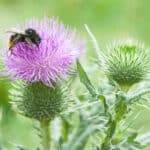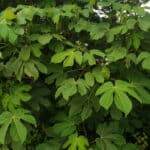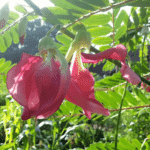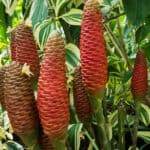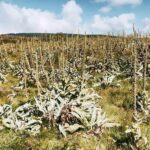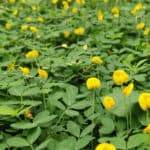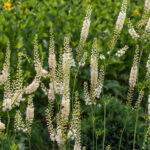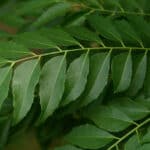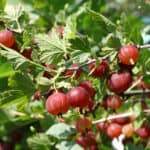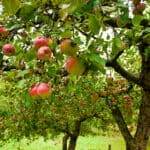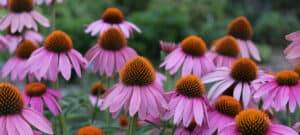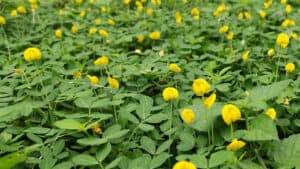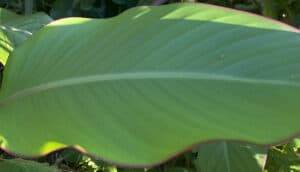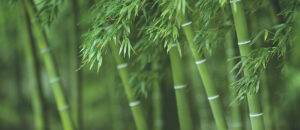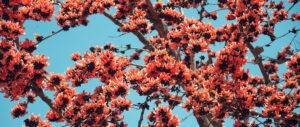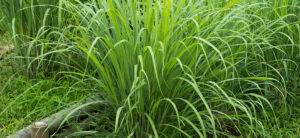When observing skullcap, you must close to the damp earth – amongst the weeds and tall grasses to view this small herbaceous perennial. Skullcap is an inconspicuous little plant, blending into its surroundings, often going unnoticed. This quality is particularly interesting, for it is a powerful and gentle medicine that is anything but small or unnoticeable. Indeed, skullcap is one of my top medicinal allies, and it has aided me when I can’t sleep, have a horrible pounding headache, and when my nervous system needs a nourishing touch.
Plant Overview
While the Scutellaria genus consists of over 300 species, S. lateriflora is the primary species used in traditional and modern Western herbal medicine. It grows wild as a native species to the northeastern and northwestern United States and adjacent areas in Canada. S. lateriflora prefers partial shade in open wet meadows, stream banks, and alongside rivers and lakes.
As a Lamiaceae or mint family member, it bears the classic square stem, opposite leaves, and two-lipped flowers. Its leaves aren’t too aromatic, so skullcap’s most distinguishing feature is its bluish-to-purple flowers, which grow along a single side of the stem. Skullcap’s species name, lateriflora, refers to this growth characteristic as it means “to flower on the side,” as in lateral flower.
The genus name, Scutellaria, refers to the shape of the calyx. Scutella is Latin for “shield” and may refer to how the calyx resembles a miniature medieval helmet. Other sources claim Scutella means “little dish” and refers to the lid of the calyx.
As there are a few hundred species within the genus Scutellaria, skullcap has been used medicinally throughout the world and grows in many different climates. In Traditional Chinese Medicine, they use their native skullcap, Scutellaria baicalensis, which has been used for over 2000 years. Although many Scutellaria species are medicinal, they are not interchangeable with S. lateriflora.
S. lateriflora is a traditional Native American remedy, and it was through their teachings that it was adopted and used by the early settlers in the 18th century. It was brought to Great Britain in the 19th century and was used as a reliable remedy by herbal and Eclectic physicians for a range of disorders, including schizophrenia and epilepsy. Today, skullcap isn’t used to the extent it previously was (by most herbalists), but it is still an invaluable remedy that deserves a space in your medicine cabinet.
Propagation and Planting
Skullcap grows in zones 3-8 in part shade to full sun. Only plant skullcap in full sun if you live in a cool climate, as it prefers cooler temperatures which can be achieved through shade during the heat of the day. Soil pH range is 6-8, and it thrives in rich, moist soil with an abundance of organic matter.
Skullcap is easily propagated from root division, vegetative cutting, or cultivated from seed. As it spreads by runners, you can take a cutting that includes a good bit of the underground running stem, and it should successfully take. If you decide to take a few cuttings, place them in a cool, shady place and give them regular water until they’re ready to be transplanted.
If starting skullcap from seed, you’ll receive the best germination rates if you give the seeds a cold, moist stratification period of 30 to 60 days. You can achieve this by using the refrigerator method (mixing the seeds with damp sand in a bag in the fridge) or by directly planting the seeds in the garden in the fall.
If you use the refrigerator method, the seeds can be planted in the spring after the last frost date or in seed trays. Sow the seeds ¼ inch beneath the soil. Germination occurs in 5 to 25 days at 65-70 degrees. Transplant or thin to 12 inches apart.
Growth and Care
S. lateriflora grows 1-2 feet tall and indefinitely wide as the plant spreads by runners and forms a colony. The best site for skullcap is a moist area that receives partial shade, especially if you live in a hot climate. If you have an area in your garden where water collects, or a nearby stream or pond, that is where it will be the happiest. However, it will do well in regular garden soil, but you’ll want to add generous amounts of compost and organic matter. Mulching around the plants will also help keep the soil cool and moist.
If you live in a dry climate, take special care to water skullcap frequently, as it really does like to have its feet wet. Alternatively, you can grow skullcap in a large pot or container, such as a retired bathtub. That way, you can control the soil moisture easier and won’t have to water as frequently.
When adding organic matter and compost to the soil, be careful to not add too much available nitrogen, such as animal manure, as this will cause heavy leaf growth. Skullcap’s stems are weak, so they cannot support the extra leaf growth, causing them to lean heavily or break. I can personally attest to this, as I added aged horse manure to the soil in early spring before I knew this helpful tidbit about skullcap. Sure enough, my plants grew broad and luscious with heavy leaf growth. Some plants fell over on their side due to the extra weight. Luckily, the patch did okay (overall) with the extra load, and I harvested all the leaning plants.
When adding nitrogen-rich amendments to the soil (manures and compost), you can balance them out by adding nitrogen-poor amendments, such as leaf mold, pine bark fines, and peat moss. In this way, you are still providing fertile, rich soil without worrying about excess nitrogen, which skullcap will be ever so grateful for.
Pests and Diseases
Fortunately, skullcap doesn’t have many problems with insects or diseases. Powdery mildew, a fungal disease that produces a white, powder-like substance on leaves, is the only common disease you’re likely to encounter.
The main contributors to a powdery mildew outbreak are moisture, poor air circulation, and dense plantings. Thus, to prevent powdery mildew, there are a few steps you can take. First, monitor how much available nitrogen you add to the soil, as excess nitrogen can contribute to the problem. Second, water the base of the plants rather than watering overhead, which will cause water to form on the leaves. Lastly, thin your patch if it’s grown dense. If you notice any diseased plants or leaves, remove them immediately to prevent spreading.
I’ve found that powdery mildew (or any pest or disease) doesn’t spread as easily when plants are intermixed with other plant species. For this reason, I plant a few different medicinal herbs in a single bed rather than just a single plant.
Harvesting
Whenever I go to harvest, I spend a few moments beforehand sitting with the plant. I take this time to settle myself, observe the plant, and set any intentions if it feels right to do so. I then ask for permission, and if I receive a “yes,” I’m ready to harvest. In requesting permission, I honor the plant and acknowledge its life and the medicine it provides. When asking permission, let your heart guide you – it will know the answer.
The medicinal parts of S. lateriflora are the aerial parts (leaves, flowers, and stems). Skullcap is ready to harvest as soon as it starts flowering, around mid to late summer. Cut the stems near their base in the morning after the dew has dried. Take care not to pick the stems out of the soil, as they have a delicate root system. Hang in bundles to dry in a warm, dark, dry place. To prepare a fresh tincture, strip the leaves, flowers, and tender stems from the main fibrous stem.
I harvest one-third of my patch and let the rest go to seed and continue to spread. This promotes healthy growth and a larger patch to harvest from next spring.
If harvesting from the wild and you find a single skullcap plant or a small patch, look around and see if there are other plants/patches nearby. You don’t want to harvest the first plants you come across, as they may be the only plants around. While skullcap isn’t an at-risk herb, it is by no means a weedy or overly common plant. For this reason, I prefer to cultivate skullcap in my garden (where I can grow a large and luscious patch) rather than harvest wild plants.
Medicinal Uses
Medicinal Actions:
- Nervine (hypnotic and trophorestorative)
- Anodyne
- Astringent
- Bitter tonic
- Spasmolytic
- Hypotensive
Skullcap primarily works as a nervine through its strong relaxing and toning effect on the autonomic nervous system. All other medicinal actions of S. lateriflora are secondary to its primary nervine action. The bitter tonic action may be an expectation, but its bitter action is strengthened through its nervine action, indicating it for digestive issues associated with nervous tension, stress, or anxiety.
I have found skullcap to be wonderfully soothing and relaxing. As a nervine trophorestorative, it rebuilds and strengthens the nervous system, helping one to be more resilient to stress. It helps lessen the symptoms associated with a depleted or frayed nervous system through its restorative action, such as anxiety, insomnia, paranoia, heightened reactions, sensitivity to sound and light, and overwhelming stress.
Herbalist Sajah Popham notes that the nervine and relaxant action is produced primarily through baicalein, the prominent flavonoid in skullcap. Baicalein binds to benzodiazopene sites on GABA-A receptors. GABA is responsible for producing feelings of calm and relaxation in the body. When baicalein binds to these receptors, it changes the response to stimulus, classifying it as a “positive allosteric modulator.” Because it stimulates the receptor, it increases the effect of benzodiazopene, which increases the sensation of feeling calm and relaxed (Popham, 2020).
As a hypnotic nervine, skullcap has a mild sedative effect on the nervous system, which can help one relax and fall asleep. Skullcap isn’t one of the strongest hypnotics, so it’s safe for children and the elderly. Its hypnotic effects are most noticeable in a strong infusion (herbal tea) rather than the tincture. Moreover, its hypnotic effects are deactivated with boiling water, so if you’re making a skullcap tea to help you fall asleep, you’ll want to boil the water and allow it to cool for about 5 minutes before pouring it over the dried herb. I use an electric tea kettle, and I’ve found 185 to 190 degrees to be the “sweet” spot for skullcap’s hypnotic effects.
For insomnia, Sajah Popham states:
“I personally have found Skullcap to be an excellent remedy for those that experience insomnia due to heightened sensory faculties, in particular sound. If people complain they can’t sleep because every little creek of the house, pitter-patter of a pet walking on the floor, drips of water going through the gutter, etc. either keep them awake, or jolt them awake when they’re right at that edge of sleep. The other area it’s quite specific for sleep is for people that can’t sleep due to muscle twitches or spasms. This can be the incessantly annoying eyelid twitch to more painful cramping of the smooth or skeletal muscles.”
Skullcap is specific for muscle cramps and spasms, and headaches through its anodyne (pain-relieving) and antispasmodic action. Because of its bitter tonic action, it is especially helpful for cramps in the digestive system and uterus. It effectively relaxes the smooth muscles of the uterus and the GI tract, easing painful cramps. It is also indicated for headaches brought on by stress with associated tension in the neck and shoulders. I have also found it to help relieve headaches associated with liver congestion, as its bitter tonic action helps to stimulate the liver and increase bile production, while its anodyne properties ease tension in the mind (both physically and psychologically).
I have suffered from intense, pounding headaches brought about by stress and a congested/stagnant digestive system. When stressed, my digestive system tightens, as well as my neck and shoulders, decreasing blood flow to my brain. I’ve found skullcap and valerian to be the most effective for this type of headache
Skullcap also possesses the ability to lower blood pressure (hypotensive). Again, this is brought about through skullcap’s strong relaxant effect on the nervous system and throughout the entire body. When stressed, everything within our body tenses up and constricts, including the blood vessels. Skullcap helps relax and ‘loosen’ the blood vessels, allowing unrestricted blood flow. In this way, it is indicated for hypertension, specifically when hypertension is associated with chronic stress.
Safety Profile
While skullcap is a powerful remedy, it is quite gentle, making it safe for children, pregnant or nursing individuals, and the elderly.
There has been concern about skullcap’s potential for hepatotoxicity (liver damage). This is because there have been issues with skullcap adulterants, specifically, pink skullcap (Teucrium chamaedrys), a germander variety that resembles skullcap. Unknowingly, people have taken “pink skullcap” or other germander species thinking it was the true, medicinal skullcap due to the adulterants.
Pink skullcap possesses hepatotoxic properties, so skullcap was lumped with a reputation for causing liver damage. Recent studies have shown skullcap (S. lateriflora) does not possess any hepatotoxic properties, so there isn’t any reason to avoid using skullcap for fear of liver damage. However, adulteration is still a concern, so make sure only to purchase the dried herb or tincture of skullcap from a reliable and trustworthy source.
I say, all the more reason to grow it ourselves!
Final Thoughts
Not only does skullcap bring happiness through its incredible medicinal actions, but also the beauty of the living plant is sure to bring joy to your heart. Skullcap isn’t showy, nor does it produce the brightest flowers in the garden, but to me, it is one of the most beautiful medicinal herbs. Its dark green leaves and dainty, fairy-like flowers have a magical joyfulness to them.
I hope you feel inspired to bring this little herb into your garden. It is incredibly easy to grow and is a wonderful companion plant. I’ve found it sheltering little frogs and resting bumblebees; it creates safety within one’s body and mind and safety for the wee folk and little creatures of the land. If you find a place for it in your garden, it will be sure to find a place in your heart.




